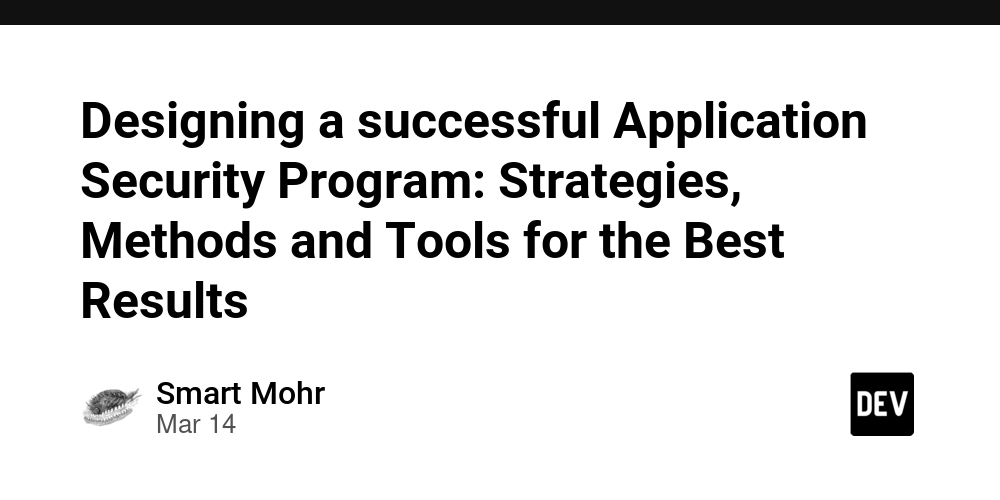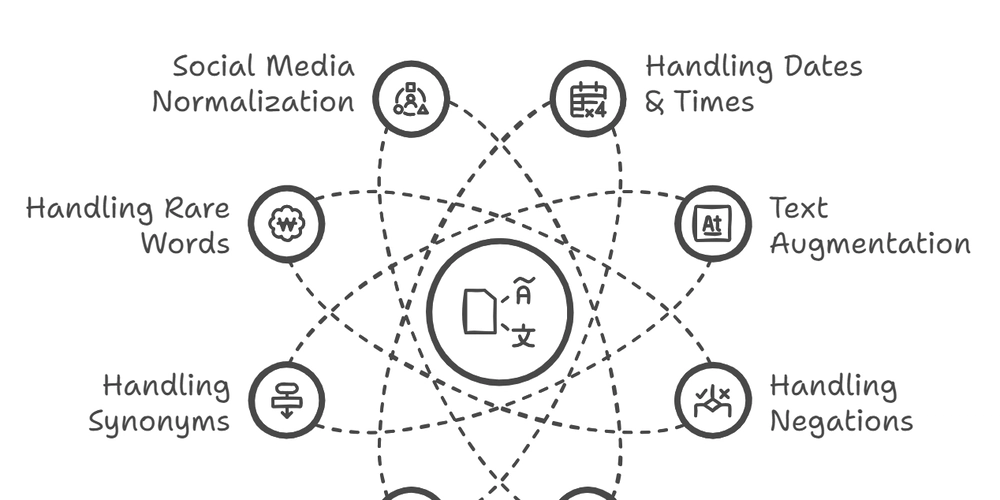Designing a successful Application Security Program: Strategies, Methods and Tools for the Best Results
AppSec is a multi-faceted, robust strategy that goes far beyond the simple vulnerability scan and remediation. The constantly changing threat landscape coupled with the rapid pace of technological advancement and the growing intricacy of software architectures, requires a holistic and proactive approach that seamlessly incorporates security into every stage of the development lifecycle. AI application security This comprehensive guide explores the key elements, best practices, and the latest technologies that make up an extremely effective AppSec program, empowering organizations to safeguard their software assets, mitigate risk, and create an environment of security-first development. A successful AppSec program relies on a fundamental shift in the way people think. Security should be seen as a key element of the development process, and not an extra consideration. This paradigm shift necessitates close collaboration between security teams as well as developers and operations personnel, breaking down the silos and creating a sense of responsibility for the security of the applications they develop, deploy and manage. When adopting a DevSecOps approach, companies can incorporate security into the fabric of their development workflows and ensure that security concerns are considered from the initial stages of concept and design until deployment and maintenance. One of the most important aspects of this collaborative approach is the establishment of specific security policies, standards, and guidelines that provide a framework for safe coding practices, vulnerability modeling, and threat management. These policies should be based upon industry best practices, such as the OWASP top ten, NIST guidelines and the CWE. They should also take into consideration the distinct requirements and risk that an application's and business context. These policies can be codified and easily accessible to all parties to ensure that companies implement a standard, consistent security policy across their entire application portfolio. To implement these guidelines and make them relevant to the development team, it is crucial to invest in comprehensive security training and education programs. These initiatives should equip developers with the skills and knowledge to write secure code and identify weaknesses and apply best practices to security throughout the development process. The course should cover a wide range of subjects, such as secure coding and common attack vectors as well as threat modeling and principles of secure architectural design. Companies can create a strong base for AppSec by creating an environment that encourages constant learning, and by providing developers the resources and tools they require to incorporate security into their work. Organizations should implement security testing and verification procedures along with training to find and fix weaknesses prior to exploiting them. This requires a multi-layered approach, which includes static and dynamic analysis methods in addition to manual code reviews and penetration testing. The development phase is in its early phases Static Application Security Testing tools (SAST) are a great tool to identify vulnerabilities such as SQL Injection, Cross-Site scripting (XSS) and buffer overflows. Dynamic Application Security Testing tools (DAST) are however, can be used to simulate attacks against applications in order to find vulnerabilities that may not be found through static analysis. These tools for automated testing can be very useful for the detection of vulnerabilities, but they aren't an all-encompassing solution. manual penetration testing performed by security experts is equally important to uncovering complex business logic-related vulnerabilities that automated tools could overlook. Combining automated testing with manual validation, organizations can gain a better understanding of their overall security position and make a decision on the best remediation strategy based upon the severity and potential impact of identified vulnerabilities. To enhance the efficiency of an AppSec program, businesses should think about leveraging advanced technologies such as artificial intelligence (AI) and machine learning (ML) to augment their security testing capabilities and vulnerability management. AI-powered tools can examine large amounts of application and code data and identify patterns and anomalies that could signal security problems. These tools can also learn from previous vulnerabilities and attack patterns, continuously increasing their capability to spot and avoid emerging security threats. One particularly promising application of AI in AppSec is the use of code property graphs (CPGs) that can facilitate an accurate and more efficient vulnerability identification and remediation. CPGs provide a rich and visual representation of the application's codebase. They capture not just the syntactic structure of the code, but additionally the intricate

AppSec is a multi-faceted, robust strategy that goes far beyond the simple vulnerability scan and remediation. The constantly changing threat landscape coupled with the rapid pace of technological advancement and the growing intricacy of software architectures, requires a holistic and proactive approach that seamlessly incorporates security into every stage of the development lifecycle. AI application security This comprehensive guide explores the key elements, best practices, and the latest technologies that make up an extremely effective AppSec program, empowering organizations to safeguard their software assets, mitigate risk, and create an environment of security-first development.
A successful AppSec program relies on a fundamental shift in the way people think. Security should be seen as a key element of the development process, and not an extra consideration. This paradigm shift necessitates close collaboration between security teams as well as developers and operations personnel, breaking down the silos and creating a sense of responsibility for the security of the applications they develop, deploy and manage. When adopting a DevSecOps approach, companies can incorporate security into the fabric of their development workflows and ensure that security concerns are considered from the initial stages of concept and design until deployment and maintenance.
One of the most important aspects of this collaborative approach is the establishment of specific security policies, standards, and guidelines that provide a framework for safe coding practices, vulnerability modeling, and threat management. These policies should be based upon industry best practices, such as the OWASP top ten, NIST guidelines and the CWE. They should also take into consideration the distinct requirements and risk that an application's and business context. These policies can be codified and easily accessible to all parties to ensure that companies implement a standard, consistent security policy across their entire application portfolio.
To implement these guidelines and make them relevant to the development team, it is crucial to invest in comprehensive security training and education programs. These initiatives should equip developers with the skills and knowledge to write secure code and identify weaknesses and apply best practices to security throughout the development process. The course should cover a wide range of subjects, such as secure coding and common attack vectors as well as threat modeling and principles of secure architectural design. Companies can create a strong base for AppSec by creating an environment that encourages constant learning, and by providing developers the resources and tools they require to incorporate security into their work.
Organizations should implement security testing and verification procedures along with training to find and fix weaknesses prior to exploiting them. This requires a multi-layered approach, which includes static and dynamic analysis methods in addition to manual code reviews and penetration testing. The development phase is in its early phases Static Application Security Testing tools (SAST) are a great tool to identify vulnerabilities such as SQL Injection, Cross-Site scripting (XSS) and buffer overflows. Dynamic Application Security Testing tools (DAST) are however, can be used to simulate attacks against applications in order to find vulnerabilities that may not be found through static analysis.
These tools for automated testing can be very useful for the detection of vulnerabilities, but they aren't an all-encompassing solution. manual penetration testing performed by security experts is equally important to uncovering complex business logic-related vulnerabilities that automated tools could overlook. Combining automated testing with manual validation, organizations can gain a better understanding of their overall security position and make a decision on the best remediation strategy based upon the severity and potential impact of identified vulnerabilities.
To enhance the efficiency of an AppSec program, businesses should think about leveraging advanced technologies such as artificial intelligence (AI) and machine learning (ML) to augment their security testing capabilities and vulnerability management. AI-powered tools can examine large amounts of application and code data and identify patterns and anomalies that could signal security problems. These tools can also learn from previous vulnerabilities and attack patterns, continuously increasing their capability to spot and avoid emerging security threats.
One particularly promising application of AI in AppSec is the use of code property graphs (CPGs) that can facilitate an accurate and more efficient vulnerability identification and remediation. CPGs provide a rich and visual representation of the application's codebase. They capture not just the syntactic structure of the code, but additionally the intricate interactions and dependencies that exist between the various components. AI-powered tools that make use of CPGs can perform a deep, context-aware analysis of the security of an application, and identify vulnerabilities which may have been overlooked by traditional static analyses.
Additionally, CPGs can enable automated vulnerability remediation through the use of AI-powered code transformation and repair techniques. By understanding the semantic structure of the code and the characteristics of the weaknesses, AI algorithms can generate specific, contextually-specific solutions that tackle the root of the problem instead of only treating the symptoms. This approach not only accelerates the remediation process but lowers the chance of creating new vulnerabilities or breaking existing functions.
Another crucial aspect of an efficient AppSec program is the incorporation of security testing and verification into the continuous integration and continuous deployment (CI/CD) process. Through automating security checks and integrating them into the build and deployment process organizations can detect vulnerabilities in the early stages and prevent them from getting into production environments. The shift-left security method can provide rapid feedback loops that speed up the amount of time and effort required to identify and fix issues.
To attain this level of integration, organizations must invest in the appropriate infrastructure and tools to help support their AppSec program. This goes beyond the security testing tools but also the platform and frameworks that allow seamless automation and integration. Containerization technologies such as Docker and Kubernetes can play a vital role in this regard by giving a consistent, repeatable environment for conducting security tests while also separating potentially vulnerable components.
Effective communication and collaboration tools are just as important as the technical tools for establishing an environment of safety, and enabling teams to work effectively together. Issue tracking systems like Jira or GitLab help teams determine and control weaknesses, while chat and messaging tools like Slack or Microsoft Teams can facilitate real-time exchange of information and communication between security professionals and development teams.
The effectiveness of an AppSec program is not solely dependent on the technologies and instruments used and the staff who are behind it. Building a strong, security-focused culture requires the support of leaders, clear communication, and an ongoing commitment to improvement. Organisations can help create an environment that makes security more than just a box to mark, but an integral part of development by fostering a sense of responsibility engaging in dialogue and collaboration, providing resources and support and creating a culture where security is an obligation shared by all.
In order for their AppSec programs to continue to work in the long run Organizations must set up relevant metrics and key performance indicators (KPIs). These KPIs will allow them to track their progress as well as identify improvement areas. The metrics must cover the entire lifecycle of an application that includes everything from the number and nature of vulnerabilities identified in the development phase through to the time it takes to fix issues to the overall security position. By monitoring and reporting regularly on these metrics, businesses can demonstrate the value of their AppSec investment, discover trends and patterns and take data-driven decisions about where to focus on their efforts.
In addition, organizations should engage in ongoing learning and training to keep pace with the constantly evolving threat landscape and emerging best methods. Attending industry events or online courses, or working with experts in security and research from the outside can help you stay up-to-date on the latest trends. By fostering an ongoing learning culture, organizations can assure that their AppSec program is able to be adapted and resilient to new threats and challenges.
It is essential to recognize that application security is a continual process that requires constant investment and dedication. As new technology emerges and development practices evolve companies must constantly review and review their AppSec strategies to ensure they remain effective and aligned with their objectives. Through adopting a continual improvement approach, encouraging collaboration and communication, and making use of advanced technologies like CPGs and AI organisations can build a robust and adaptable AppSec program that can not only secure their software assets but also let them innovate in an increasingly challenging digital environment.AI application security












































































































































































![[The AI Show Episode 142]: ChatGPT’s New Image Generator, Studio Ghibli Craze and Backlash, Gemini 2.5, OpenAI Academy, 4o Updates, Vibe Marketing & xAI Acquires X](https://www.marketingaiinstitute.com/hubfs/ep%20142%20cover.png)



























































































































![[DEALS] The Premium Learn to Code Certification Bundle (97% off) & Other Deals Up To 98% Off – Offers End Soon!](https://www.javacodegeeks.com/wp-content/uploads/2012/12/jcg-logo.jpg)


![From drop-out to software architect with Jason Lengstorf [Podcast #167]](https://cdn.hashnode.com/res/hashnode/image/upload/v1743796461357/f3d19cd7-e6f5-4d7c-8bfc-eb974bc8da68.png?#)









































































































.png?#)

































_Christophe_Coat_Alamy.jpg?#)
 (1).webp?#)




































































































![iPhone 17 Pro Won't Feature Two-Toned Back [Gurman]](https://www.iclarified.com/images/news/96944/96944/96944-640.jpg)
![Tariffs Threaten Apple's $999 iPhone Price Point in the U.S. [Gurman]](https://www.iclarified.com/images/news/96943/96943/96943-640.jpg)





































































































































